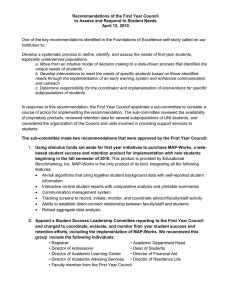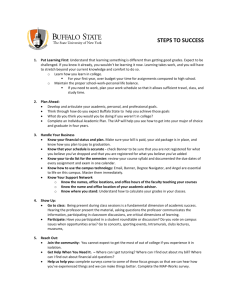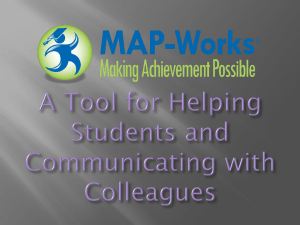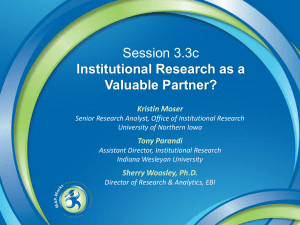MAP-Works: An Example of Best Practices in Assessment
advertisement
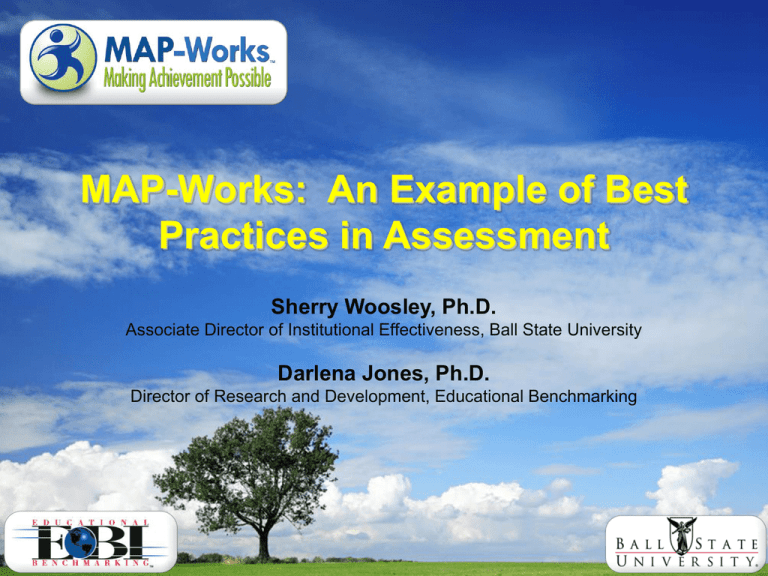
MAP-Works: An Example of Best Practices in Assessment Sherry Woosley, Ph.D. Associate Director of Institutional Effectiveness, Ball State University Darlena Jones, Ph.D. Director of Research and Development, Educational Benchmarking Best Practices? Best Practices in Assessment What are some Best Assessment Practices? Our list Involves multiple constituencies Asks important questions / Focuses attention on important issues Solid methodology Clear links to practice User-friendly reporting Leads to reflection and action by faculty/staff and students MAP-Works Overview Who is Responsible? Who is responsible for student success on your campus? Enrollment Management / Retention Provost / VP Acad Affairs VP Student Affairs Enrollment / Retention Management? Vice President of Student Affairs Provost / Vice President of Academic Affairs? What information do you know about this first-year student? Do you really know them? Student ID: YD252952 HS GPA: 3.93 SAT Verbal: 29 Location: In state Gender: Female Race: African American Age: 18 Major: Undecided Paradigm Shift What would happen if… ALL faculty/staff were responsible for student success? You knew that student was struggling Could you do something about it before it was too late? I’m really homesick I’m thinking about transferring Enrollment Management / Retention Provost / VP Acad Affairs First-Year Seminar Instructor Financial Aid Minority I don’t think I can Student Affairs afford college I’m struggling in my math class VP Student Affairs Residence Hall Staff Academic Advisor Academic Department Heads My roommate and I argue all the time MAP-Works History In 1988, Ball State had a number of concerns… Unrealistic expectation of first-year students (academics, grades, housing, etc.) Retention rates Mid-term was too late Need for better data about incoming students Timeline: 1988: Ball State developed the concept. 1989-2004: Ball State used MAP in-house. 2005: Ball State partnered with EBI to create MAP-Works. Fall 2007: Huntington University was 1 of 10 institutions to pilot MAP-Works. Fall 2008: Huntington is one of 41+ institutions implementing MAP-Works (version 4.0). MAP-Works Focus Retention Minimize percentage of capable students who drop out due to issues that could have been addressed by self awareness or timely intervention by professional staff. Academic & Socio-Emotional Success Improve students' ability to succeed academically by realigning behavior with grade expectations and focusing on elements of academic success. Address socio-emotional transition issues. MAP-Works Process • Expectations • Behaviors • Social Norming • Expectations • Campus Resources • Student Profile • Institution Profile • Campus Resources • Student Summary • Scan Students Survey and Profile Items Understanding the Student’s Experience Profile Information Student information like gender and race/ethnicity Entrance exam scores # credit hours enrolled Self-Assessment Communication Skills Analytical Skills Self-Discipline Time Management Health and Wellness Issues (stress, financial, etc. ) Academic Integration Academic Self-Efficacy Core Academic Behaviors Advanced Academic Behaviors Commitment to Higher Education Social Integration Peer Connections Living Environment (on/off campus) Roommate Relationships (on/off campus) Homesickness Best Practices in Assessment Sharing Information with Faculty/Staff Best Practices in Assessment Tips… Identify students who are… Non-Respondents At-risk for retention or poor academic performance Reporting interests in leadership opportunities or student activities Make information valuable in student-to-staff meetings Identify common issues among your students Supporting work of faculty/staff Tip 1: Identify Non-Respondents Did You Know? For most campuses, non-response is one of the first signs of disconnect Filter by “Responded” or “Not Responded” Make locating non-respondents quick and easy! Tip 2: Identify At-Risk Students Did You Know? Some students decide if they’re coming back in spring term within a few days of beginning their fall term Students sorted by warning indicators Make locating at-risk students easy to help faculty/staff Tip 3: Identify Students with Interests Did You Know? Some students are eager to begin exploring leadership opportunities immediately Choose a survey or profile question Make locating students with special interests easy! Tip 4: Information for Meetings Students are more likely to be truthful on surveys than face-toface Use only the most valuable information in an easy-to-read format Tip 5: Identifying Common Issues Being creative in programming may help eliminate common issues experienced by your students Homesickness is an issue for a lot of students Provide aggregate reporting for program improvement Tip 5: Keep Records Choose the type of contact then leave a short comment regarding the contact Providing your faculty/staff ways to keep notes on their students will improve their efficiency Provide an easy-to-use method to store notes Tip 6: Organize Your Work with Students Providing a way for faculty/staff to group their students based on common issues/interests makes interventions easier to manage Provide an easy way to manage students’ issues Tip 7: Notifying Others of Issues Notifying other faculty/staff in better positions to aid the student will likely help that student transition Provide a method of communication across silos Group Work Look at the student and discuss the following.. What interventions would you propose? What resources would you recommend? Which of the organize, communicate, and coordinate tools might be useful for working with this student? What changes in the situation might warrant different tools? Tools: Student Lists Logging Contacts Private Notes Shared Notes Yellow Alerts Red Alerts Best Assessment Practices: Sharing Information with Students Assessment and Students Good Assessment impacts students’ lives by improving programs Great Assessment provides valuable information directly to students so that they can improve their lives Student Reporting What is it? Students receive their own individualized report Why? To help students realign expectations of what it will take to succeed in college To allow them to see comparisons with their peers To connect them with campus resources Making the Point: Messages are reinforced with student quotes and summary conclusions. Expectations: Helping students establish more realistic expectations about what it takes to successfully transition to college. Reality Check: Study skills and study time not likely to produce desired grades. Social Norming: Student self evaluations are calibrated with their peers to identify strengths and weaknesses. Links to Campus Resources: Campus specific resource links allow your students to reach in and exploit all your campus has to offer. Sophomore Transition Survey What is it? MAP-Works for sophomore students Similar survey Additional questions about academic major, career plans, etc. Same system and reporting Concluding thoughts The focus is students – all students. MAP-Works is a powerful tool that can be used to support student success. Faculty and staff are critical. MAP-Works is evolving. Many of this year’s enhancements are a result of user feedback. You will have an opportunity to provide feedback for improvements. Q&A Thank you. Sherry Woosley, Ph.D. Associate Director of Institutional Effectiveness & Adjunct Professor of Sociology, Ball State University Darlena Jones, Ph.D. Director of Research and Development, Educational Benchmarking www.webebi.com or www.MAP-Works.com
